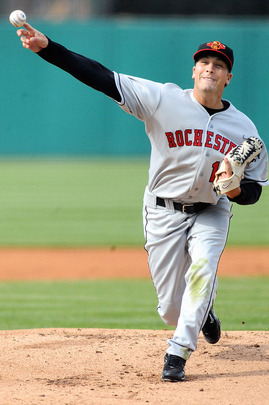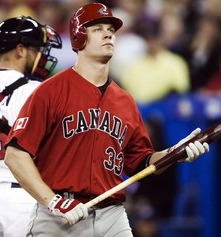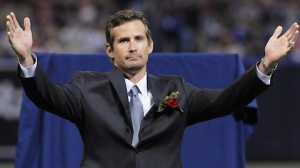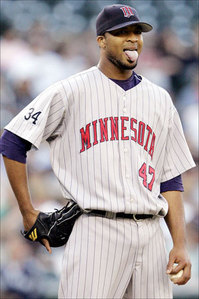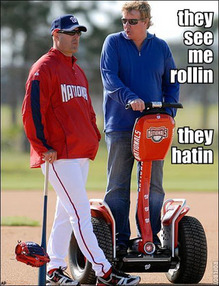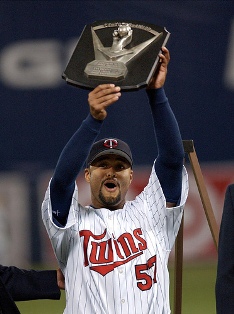 With the recent call-up of right-hander Kevin Mulvey, now seems
With the recent call-up of right-hander Kevin Mulvey, now seems
like a really good time to re-examine the Santana trade. Here is a
look at what the Twins got:
Carlos Gomez:
2008: .258/.296/.360/.657 OPS 2.3 WAR
2009: .253/.291/.358/.649 OPS 0.1 WAR
Gomez’s
horrible numbers at the plate are sort of neutralized by his defense.
With a career 23.5 UZR in center, he is one of the top defensive CFs in
the league. If he could just learn to hit, he would be one of the better
all-around players in the league, much like Grady Sizemore. One of
the things Go-Go really needed to work on was plate discipline, and he
has indeed improved in this respect. Last season, he swung at 36.8 %
of pitches outside the strike zone, while this season he has only
chased 27.6%. Thus, his BB/K ratio has subsequently improved from 0.18
to 0.36. So far, he has little to show for his improved plate
discipline, but he hasn’t seen much playing time this season with the
crowded outfield situation, either. It’s doubtful that Go-Go will ever
develop much power, but given his age and a continued improvement in
plate discipline, it’s not unreasonable to expect league-average production from him eventually.
Philip Humber:
2008:
Twins: 4.36 ERA 1.371 WHIP 1.20 K/BB 4.6 K/9 3.9 BB/9 11.2 IP
Rochester: 4.56 ERA 1.423 WHIP 2.16 K/BB 7.0 K/9 3.2 BB/9 136.1 IP
2009:
Twins: 12.45 ERA 3.231 WHIP 1.33 K/BB 8.3 K/9 6.2 BB/9 4.2 IP
Rochester: 5.86 ERA 1.575
WHIP 1.97 K/BB 7.2 K/9 3.7 BB/9 73.2IP
Humber
was once the Mets’ top pitching-prospect, until he was sidelined with
Tommy-John surgery in 2005. He’s been a mediocre starter for the Red
Wings, and at this point (he’s 26) doesn’t project to be more than a
long-reliever in the major leagues. Not only have walks been an issue
for Humber at the major-league level, he’s also had trouble keeping the
ball in the park (his HR/FB% is 18.2). The fact that nobody claimed
him when the Twins put him on waivers earlier this season (and that
they were willing to risk losing him this way), probably says a lot
about his value.
Kevin Mulvey:
2008: 3.77 ERA 1.351 WHIP 2.52 K/BB 7.4 K/9 2.9 BB/9 148.0 IP
2009:
3.93 ERA 1.427 WHIP 2.13 K/BB 7.1 K/9 3.3
BB/9 103.0 IP
Mulvey
has spent the past two seasons as a starter in Rochester, and though
he’s been pretty successful, he’s struggled to pitch effectively on a
consistent basis. Still, his K/9 rate is good enough to suggest that
he might make it as a fifth starter or middle reliever in the major
leagues. If anything, a good performance with the big club would
probably increase his trade value should the team dangle him in an
effort to upgrade the bullpen or middle infield.
Deolis Guerra:
2008 (Ft. Myers):
5.47 ERA 1.608 WHIP 1.00 K/BB 4.9 K/9 4.9 BB/9 130.0 IP
2009:
Ft. Myers: 4.69
ERA 1.390 WHIP 2.28 K/BB 5.9 K/9 2.6 BB/9 86.1 IP
New Britain: 5.59
ERA 1.655 WHIP 2.67 K/BB 7.4 K/9 2.8 BB/9 9.2 IP
Guerra
is the youngest and most intriguing of the three pitching prospects the
Twins got in the deal. The fact that he’s spent four years in A-ball
isn’t particularly inspiring, but he’s still only 20 years old and is
quite young even for that level. Guerra was recently promoted to AA,
despite his poor numbers, in the hopes that a change in scenery will do
him some good. It’s unlikely that he will ever develop into an ace,
and it’s questionable whether he will ever even reach the major
leagues, but it’s also too soon to give up on him just yet.
And here’s what the Mets got:
Johan Santana: 2.53 ERA 3.83 xFIP 1.15 WHIP 3.27 K/BB 4.8 WAR
Note
that I am only including his 2008 numbers. I did this because, let’s
face it, his leaving was a foregone conclusion. There is no way the
Twins were going to re-sign Johan, they would undoubtedly have been
outbid for his services by one of the larger-market teams. This is
also why it’s not really accurate to say the Mets fleeced the Twins in
this deal: the Twins were going to lose Santana anyway, and the Mets
gave up a ton of prospects as well as a ton of money to acquire him.
Obviously, the Mets have come out on top so far, but dealing a
superstar near free agency is always an iffy proposition and teams
rarely get an adequate haul in return. It’s not like the Delmon Young
trade, in which the Twins gave up two very talented young players who
were under their control for the next several years and got three
barely replacement-level players in return (and the centerpiece of that
deal is considerably below replacement-level). That is highway robbery.
Now,
one can certainly make the case that the Twins didn’t have to trade
Santana, even though losing him was inevitable. It’s true that the
Twins might have been better off with the additional draft picks they
would have gotten from whatever team he eventually signed with. The
team almost certainly would’ve made the playoffs with Johan anchoring
the rotation last year, though I doubt very much they actually would
have won the World Series (having an unusually-high BA with RISP only
gets you so far). But from all accounts, Bill Smith was left with
little choice but to deal the superstar, since Santana wanted his
contract situation resolved before the start of the season. He didn’t
want to have to endure the media circus and speculation that dogged
Torii Hunter during his final season with the team, which is perfectly
understandable. He also made it clear that he had no intention of
being a rent-a-player (like C.C. Sabathia last year) and since he had a
full no-trade clause in his contract, waiting for a better deal to come along at the trade deadline would have been out of the question.
Smith was in his first season as GM
after Terry Ryan abruptly resigned, and was stuck with the unenviable task of trading the staff ace. As far as whether or not they
would have gotten a better package from the Yankees or the Red Sox,
it’s possible. However, we don’t really know what offers were on the
table, and if either team were really serious about trading for him.
It sounds to me like Boston and New York were willing to wait for
Santana to enter free agency, rather than lose their top prospects in
a trade. If both teams were serious about dealing for Santana, though,
and players like Ellsbury, Lester, Hughes and Cabrera really were on
the table, then Smith likely made a huge mistake in not pulling the
trigger.
 With the recent call-up of right-hander Kevin Mulvey, now seems
With the recent call-up of right-hander Kevin Mulvey, now seems